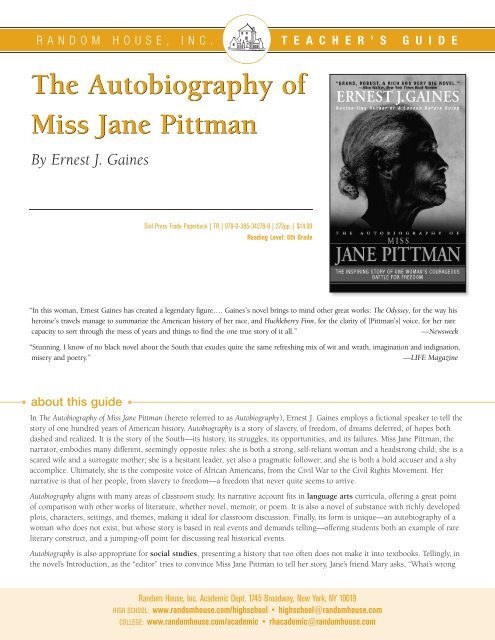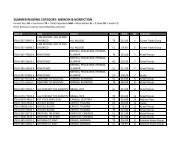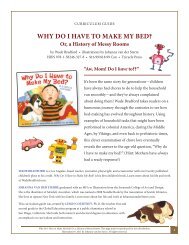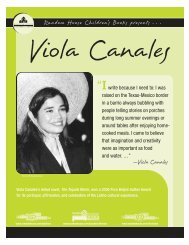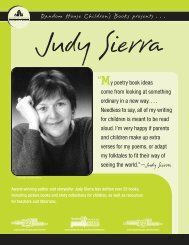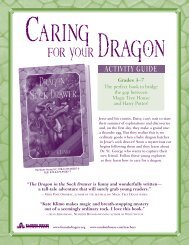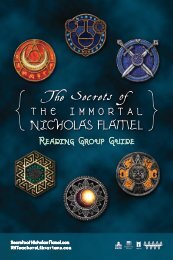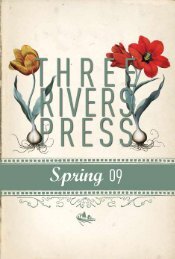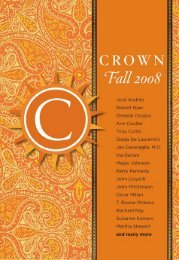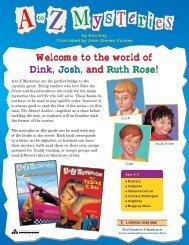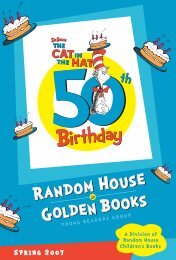The Autobiography of Miss Jane Pittman The ... - Random House
The Autobiography of Miss Jane Pittman The ... - Random House
The Autobiography of Miss Jane Pittman The ... - Random House
You also want an ePaper? Increase the reach of your titles
YUMPU automatically turns print PDFs into web optimized ePapers that Google loves.
R A N D O M H O U S E , I N C . T E A C H E R ’ S G U I D E<br />
<strong>The</strong> <strong>The</strong> <strong>Autobiography</strong> <strong>Autobiography</strong> <strong>of</strong><br />
<strong>Miss</strong> <strong>Miss</strong> <strong>Jane</strong> <strong>Jane</strong> <strong>Pittman</strong> <strong>Pittman</strong><br />
By Ernest J. Gaines<br />
about this guide<br />
Dial Press Trade Paperback | TR | 978-0-385-34278-0 | 272pp. | $14.00<br />
Reading Level: 6th Grade<br />
“In this woman, Ernest Gaines has created a legendary figure…. Gaines’s novel brings to mind other great works: <strong>The</strong> Odyssey, for the way his<br />
heroine’s travels manage to summarize the American history <strong>of</strong> her race, and Huckleberry Finn, for the clarity <strong>of</strong> [<strong>Pittman</strong>’s] voice, for her rare<br />
capacity to sort through the mess <strong>of</strong> years and things to find the one true story <strong>of</strong> it all.” —Newsweek<br />
“Stunning. I know <strong>of</strong> no black novel about the South that exudes quite the same refreshing mix <strong>of</strong> wit and wrath, imagination and indignation,<br />
misery and poetry.” —LIFE Magazine<br />
In <strong>The</strong> <strong>Autobiography</strong> <strong>of</strong> <strong>Miss</strong> <strong>Jane</strong> <strong>Pittman</strong> (hereto referred to as <strong>Autobiography</strong>), Ernest J. Gaines employs a fictional speaker to tell the<br />
story <strong>of</strong> one hundred years <strong>of</strong> American history. <strong>Autobiography</strong> is a story <strong>of</strong> slavery, <strong>of</strong> freedom, <strong>of</strong> dreams deferred, <strong>of</strong> hopes both<br />
dashed and realized. It is the story <strong>of</strong> the South––its history, its struggles, its opportunities, and its failures. <strong>Miss</strong> <strong>Jane</strong> <strong>Pittman</strong>, the<br />
narrator, embodies many different, seemingly opposite roles: she is both a strong, self-reliant woman and a headstrong child; she is a<br />
scared wife and a surrogate mother; she is a hesitant leader, yet also a pragmatic follower; and she is both a bold accuser and a shy<br />
accomplice. Ultimately, she is the composite voice <strong>of</strong> African Americans, from the Civil War to the Civil Rights Movement. Her<br />
narrative is that <strong>of</strong> her people, from slavery to freedom––a freedom that never quite seems to arrive.<br />
<strong>Autobiography</strong> aligns with many areas <strong>of</strong> classroom study. Its narrative account fits in language arts curricula, <strong>of</strong>fering a great point<br />
<strong>of</strong> comparison with other works <strong>of</strong> literature, whether novel, memoir, or poem. It is also a novel <strong>of</strong> substance with richly developed<br />
plots, characters, settings, and themes, making it ideal for classroom discussion. Finally, its form is unique––an autobiography <strong>of</strong> a<br />
woman who does not exist, but whose story is based in real events and demands telling––<strong>of</strong>fering students both an example <strong>of</strong> rare<br />
literary construct, and a jumping-<strong>of</strong>f point for discussing real historical events.<br />
<strong>Autobiography</strong> is also appropriate for social studies, presenting a history that too <strong>of</strong>ten does not make it into textbooks. Tellingly, in<br />
the novel’s Introduction, as the “editor” tries to convince <strong>Miss</strong> <strong>Jane</strong> <strong>Pittman</strong> to tell her story, <strong>Jane</strong>’s friend Mary asks, “What’s wrong<br />
<strong>Random</strong> <strong>House</strong>, Inc. Academic Dept. 1745 Broadway, New York, NY 10019<br />
HIGH SCHOOL: www.randomhouse.com/highschool • highschool@randomhouse.com<br />
COLLEGE: www.randomhouse.com/academic • rhacademic@randomhouse.com
2<br />
about this guide continued<br />
with them books you already got?” “<strong>Miss</strong> <strong>Jane</strong> is not in them,” the editor responds. <strong>Jane</strong>, the<br />
editor says, “was over a hundred years old, she had been a slave in this country, so there had<br />
to be a story.” Unfortunately, these stories have seldom been told. <strong>Jane</strong> <strong>Pittman</strong>’s story is a<br />
corrective, filling this gap in American literature, by giving voice to African American history<br />
from the 1860s to the 1960s. This book provides a springboard not only to the study <strong>of</strong><br />
history, but also to the socioeconomic conditions <strong>of</strong> African Americans during this time.<br />
note to teachers<br />
<strong>Autobiography</strong> is a very accessible text for middle and high school students. It works<br />
wonderfully as a cohesive narrative but it could also be divided, for study, through specific<br />
assignments. While the novel exposes readers to the brutality <strong>of</strong> war, slavery, poverty, and<br />
racism, the scenes are not explicit, so as not to preclude their being read by younger students.<br />
<strong>The</strong> themes <strong>of</strong> <strong>Autobiography</strong> are universal and lend themselves to classroom discussion and<br />
assignments. <strong>Miss</strong> <strong>Jane</strong>’s journey is one that teachers and students will recognize in other<br />
works and in themselves. Her experience touches on topics, both historic and current, that<br />
are part <strong>of</strong> existing language arts and social studies curricula.<br />
about the book<br />
<strong>Autobiography</strong> tells the story <strong>of</strong> one woman’s experiences, starting with her life as a slave near<br />
the end <strong>of</strong> the Civil War, up until the interview that produces the autobiography in 1962.<br />
Although presented and written as an autobiography, Gaines uses a fictional story to tell the<br />
history <strong>of</strong> African Americans during this hundred-year span. By using the voice <strong>of</strong> one storyteller,<br />
the author is able to condense the events and focus the narrative. <strong>Miss</strong> <strong>Jane</strong>’s world<br />
becomes a microcosm for African Americans in the South, and <strong>Miss</strong> <strong>Jane</strong> the allegorical<br />
Everywoman through which readers can understand this experience.<br />
Gaines breaks the novel into four books and an Introduction. <strong>The</strong> Introduction states the<br />
premise <strong>of</strong> the novel: A college history pr<strong>of</strong>essor in Louisiana is attempting to interview <strong>Miss</strong><br />
<strong>Jane</strong> about her life. <strong>The</strong> four books then trace <strong>Miss</strong> <strong>Jane</strong>’s experiences in <strong>The</strong> War Years,<br />
Reconstruction, <strong>The</strong> Plantation, and <strong>The</strong> Quarters.<br />
While <strong>Jane</strong> <strong>Pittman</strong> herself remains the center <strong>of</strong> the narrative, <strong>Autobiography</strong> tells a larger<br />
story. <strong>The</strong> novel traces the history <strong>of</strong> America, examining the nation’s struggles with race,<br />
African Americans’ unique battle with self-identity after the Civil War, and the South’s odd<br />
balance <strong>of</strong> racial tension.<br />
Though rich and wide-ranging, <strong>Autobiography</strong> ultimately remains <strong>Jane</strong>’s story––a story <strong>of</strong><br />
relationships, <strong>of</strong> self-discovery, and <strong>of</strong> triumph over hardship. Through this journey, the<br />
reader witnesses the transformation <strong>of</strong> Ticey (<strong>Jane</strong>’s slave name) to <strong>Jane</strong>.<br />
random house, inc. teacher’s guide
about the author<br />
ERNEST J. GAINES has been nominated for both the Pulitzer and Nobel Prizes for literature.<br />
His fiction, always set in fictional Bayonne, Louisiana, draws from his experiences growing<br />
up on a Southern plantation. Gaines, born on River Lake Plantation in Oscar, Louisiana,<br />
eventually moved at age fifteen to California, where he completed a degree at Stanford<br />
University before beginning his career as a novelist and college pr<strong>of</strong>essor.<br />
teaching ideas<br />
Introduction<br />
1. <strong>Autobiography</strong> is a novel. Why does Gaines use the form <strong>of</strong> autobiography? Why is the<br />
premise presented in the Introduction significant to its telling?<br />
2. Discuss the process <strong>of</strong> research. Explain the difference between primary sources and<br />
secondary sources. Have students conduct library research on an event from the<br />
recent past. <strong>The</strong>n, have students conduct interview projects, in which they interview<br />
a parent/grandparent/local resident about the same event. Discuss the differences in<br />
interpretation and recollection between the sources.<br />
3. Discuss the elements <strong>of</strong> oral history with your students. How is oral history different<br />
from written history? Through what lenses is history recorded? Discuss how these<br />
lenses affect, and even alter, events. Through what lenses are <strong>Miss</strong> <strong>Jane</strong> <strong>Pittman</strong>’s story<br />
filtered? How do these filters impact her story? Who helps <strong>Miss</strong> <strong>Jane</strong> tell her story?<br />
4. <strong>The</strong> editor’s interview takes place in the summer <strong>of</strong> 1962. Is there a significance<br />
to this date?<br />
5. Mary Hodges lives with <strong>Miss</strong> <strong>Jane</strong>. What is her role in the “editor’s” attempts to tell<br />
<strong>Jane</strong>’s story?<br />
6. Mary Hodges says, “Well, you don’t tie up all the loose ends all the time” (ix). What<br />
does Mary Hodges mean? How does her meaning apply to <strong>Jane</strong>’s story? To any story?<br />
7. At the funeral, how do the people involved in <strong>Miss</strong> <strong>Jane</strong>’s story react to its telling?<br />
What do the different reactions reveal about the story? About the people?<br />
BOOK ONE – THE WAR YEARS<br />
Soldiers<br />
1. Examine the contrast between the Confederate and Union troops as they pass the<br />
plantation. What attitudes do the soldiers express about slavery? What do the soldiers’<br />
actions show about their attitudes toward slaves and slavery?<br />
2. What is <strong>Miss</strong> <strong>Jane</strong> <strong>Pittman</strong>’s slave name? How does her name change to <strong>Jane</strong> Brown?<br />
What is <strong>Jane</strong>’s reaction to her new name? How does <strong>Jane</strong>’s mistress react to the<br />
name change?<br />
3. <strong>Jane</strong>’s story begins with the Civil War and will intersect with many world events. Begin<br />
constructing a timeline <strong>of</strong> <strong>Jane</strong>’s life. Add to the timeline as you read the book. Have<br />
students construct timelines <strong>of</strong> their own lives. What significant personal and world<br />
events intersect?<br />
HIGH SCHOOL: www.randomhouse.com/highschool • highschool@randomhouse.com<br />
COLLEGE: www.randomhouse.com/academic • rhacademic@randomhouse.com<br />
3
4<br />
teaching ideas continued<br />
Freedom<br />
1. Contrast the reactions <strong>of</strong> the field slaves and the house slaves to the Emancipation<br />
Proclamation.<br />
2. Discuss the theoretical and realistic impact <strong>of</strong> the Proclamation on slaves.<br />
3. What had happened to <strong>Jane</strong>’s parents?<br />
Heading North<br />
1. What immediate crisis <strong>of</strong> leadership occurs as the former slaves head north? Why<br />
would no one step up to lead?<br />
2. Describe Big Laura. Discuss her character and her leadership skills.<br />
3. As the former slaves head north, each one takes a new name. Discuss the significance<br />
<strong>of</strong> these new names. From where do many <strong>of</strong> the names come? Why is taking a new<br />
name essential to their journey?<br />
4. Have students research their own names. How did their parents choose their names?<br />
Do their names have family significance? Draw upon books, documents, or online<br />
resources to find the meanings <strong>of</strong> traditional names.<br />
5. How does Big Laura’s saving <strong>Jane</strong> from Brown reveal the new challenges and lingering<br />
caste system <strong>of</strong> the former slaves?<br />
Massacre<br />
1. Describe the “patrollers.” What role did they fill in the post-war South? What does their<br />
role reveal about post-war attitudes toward former slaves?<br />
2. Examine the repetitions in <strong>Jane</strong>’s narrative. What do expressions like “jumping, jumping,<br />
jumping” (22–23) and “screaming, begging; screaming, begging” (23) reveal about<br />
<strong>Jane</strong>’s thought processes and mental state? How does the first-person narrative affect<br />
readers’ understanding <strong>of</strong> the text?<br />
3. How does <strong>Jane</strong> become Ned’s de facto mother? Trace the development <strong>of</strong> this relationship<br />
as the narrative progresses.<br />
Heading South<br />
1. Under what misconceptions does <strong>Jane</strong> make her journey north? Trace these misconceptions<br />
as the journey continues.<br />
2. Discuss <strong>Jane</strong>’s encounter with the caravan headed home from Texas. What is the attitude<br />
<strong>of</strong> the former slaves in this group? How do they respond to <strong>Jane</strong>, and <strong>Jane</strong> to them?<br />
What larger differences among former slaves does this scene reveal?<br />
3. Why does the white woman cry at the end <strong>of</strong> this chapter?<br />
Shelter for the Night<br />
1. <strong>The</strong> man who helps <strong>Jane</strong> and Ned at the ferry is a New York “gov’ment invessagator.”<br />
Research the role <strong>of</strong> Northerners in the post-war South. What policies were put in<br />
place to assist former slaves? How did both Southerners and Northerners respond to<br />
newly freed slaves?<br />
2. Research the role <strong>of</strong> the Freedman’s Bureau. What was its role in the post-war South?<br />
random house, inc. teacher’s guide
teaching ideas continued<br />
All Kinds <strong>of</strong> People<br />
1. Discuss the significance <strong>of</strong> Ned’s iron and flint. What do they represent? Why does he<br />
fight to keep them?<br />
2. What does <strong>Jane</strong> learn from her encounter with Colonel Brown?<br />
3. Discuss the contrast expressed by the woman who gives <strong>Jane</strong> water while saying,<br />
“I hope the good white people round here kill all y’all <strong>of</strong>f” (43).<br />
<strong>The</strong> Hunter<br />
1. <strong>The</strong> hunter tells <strong>Jane</strong> that the former slaves headed north act “like freedom was a place<br />
coming to meet them halfway. Well it ain’t coming to meet you. And it might not be<br />
there when you get there, either” (46–47). Examine the truth <strong>of</strong> this quotation as the<br />
novel progresses. What evidence do you see <strong>of</strong> the truth <strong>of</strong> the hunter’s statement?<br />
In what way might this statement serve as the theme <strong>of</strong> the book?<br />
2. In what way is the hunter’s search different from <strong>Jane</strong>’s? In what way is it the same?<br />
An Old Man<br />
1. What does <strong>Jane</strong>’s discussion with the old man reveal about her maturity? About her<br />
capacity for the journey ahead?<br />
2. Examine pages 54 through 57. What is the old man’s assessment <strong>of</strong> <strong>Jane</strong> and Ned’s<br />
ability to make the journey to Ohio? What pitfalls does he preview in his predictions?<br />
3. At this point <strong>Jane</strong>’s narrative moves from day to day, moment to moment, to a more<br />
general recounting <strong>of</strong> her experience. Why does this shift occur? What does this shift<br />
foreshadow?<br />
Rednecks and Scalawags<br />
1. Discuss the significance <strong>of</strong> the name Job. How does this Job relate to the Biblical Job?<br />
What are the elements <strong>of</strong> this Job’s suffering?<br />
2. Discuss <strong>Jane</strong> and Ned’s situation at the end <strong>of</strong> Book One. How far have they traveled,<br />
in both their literal and non-literal journeys?<br />
BOOK II – RECONSTRUCTION<br />
A Flicker <strong>of</strong> Light; and Again Darkness<br />
1. To what light does the chapter title refer? To what darkness?<br />
2. Examine the history <strong>of</strong> Republican and Democratic politics. How have the parties<br />
changed, and remained the same?<br />
3. Research the Ku Klux Klan and other similar groups that emerged in the post-war<br />
South. Discuss their involvement in the political and social development <strong>of</strong> the region.<br />
4. <strong>Jane</strong> decides to stay, even after Mr. Bone loses the plantation to Colonel Dye. How is<br />
the decision to stay or leave different for <strong>Jane</strong> this time?<br />
Exodus<br />
1. Compare the exodus <strong>of</strong> African American slaves to the Biblical exodus. What similarities/differences<br />
to you see?<br />
2. Examine the post-war exodus <strong>of</strong> African American slaves to the North. What resulted<br />
from their move? What opportunities/disappointments awaited them?<br />
HIGH SCHOOL: www.randomhouse.com/highschool • highschool@randomhouse.com<br />
COLLEGE: www.randomhouse.com/academic • rhacademic@randomhouse.com<br />
5
6<br />
teaching ideas continued<br />
Ned Leaves Home<br />
1. Why does Ned change his name to Douglass? What change <strong>of</strong> character or direction<br />
does this name change represent for Ned?<br />
Two Letters from Kansas<br />
1. Who is Joe <strong>Pittman</strong>? In what ways does Joe replace Ned in <strong>Jane</strong>’s life?<br />
2. What updates does <strong>Jane</strong> receive from Ned? What problems does Ned encounter in<br />
Kansas? How are Ned’s problems indicative <strong>of</strong> the problems <strong>of</strong> post-war former slaves?<br />
Another Home<br />
1. Discuss the difficulties <strong>of</strong> <strong>Jane</strong> and Joe’s attempt to leave the plantation.<br />
2. What does <strong>Jane</strong>’s move to Mr. Clyde’s, and Joe’s new job, represent?<br />
Molly<br />
1. What is Molly’s reaction to <strong>Jane</strong>? How does this reaction illuminate tensions between<br />
classes <strong>of</strong> freed slaves? How does Molly’s reaction reveal a continuing plantation system<br />
and a caste system within Black society at this time?<br />
A Dollar for Two<br />
1. Maintain a timeline <strong>of</strong> <strong>Jane</strong>’s life. Compare <strong>Jane</strong>’s life to a timeline <strong>of</strong> American history.<br />
What events intersect? At what times does American history have little impact on<br />
<strong>Jane</strong>’s life?<br />
2. This chapter begins <strong>Jane</strong>’s fears for Joe’s death. Discuss her fears. What are the roots <strong>of</strong><br />
her fears? What motivates her fear? What does she do to escaper her fear?<br />
Man’s Way<br />
1. How might the black stallion be seen as a symbol?<br />
2. Who is Felton Burkes? What is his role in <strong>Jane</strong>’s life?<br />
Pr<strong>of</strong>essor Douglass<br />
1. Again, note the intersections <strong>of</strong> <strong>Jane</strong>’s life with American history. What does Ned’s<br />
service in the Army say about race at the turn <strong>of</strong> the century?<br />
2. Ned’s death is foreshadowed at the beginning <strong>of</strong> the chapter. What does this foreshadowing<br />
accomplish for readers? Why might <strong>Jane</strong> preview Ned’s death in this way?<br />
3. Examine the debate between Frederick Douglass and Booker T. Washington. On what<br />
issues do they differ? On what side <strong>of</strong> the debate does Ned fall?<br />
4. Why are whites afraid <strong>of</strong> Ned?<br />
Albert Cluveau<br />
1. What is Albert Cluveau’s relationship with <strong>Jane</strong>?<br />
2. What is Albert Cluveau’s role in society? What does the contrast between Cluveau’s role<br />
in society and his relationship with <strong>Jane</strong> show about each character? About the South?<br />
<strong>The</strong> Sermon at the River, Assassination, <strong>The</strong> People, and <strong>The</strong> Chariot <strong>of</strong> Hell<br />
1. What does Ned’s sermon explain about Black people’s role in slavery? Why does he<br />
assign this blame?<br />
2. What about Ned’s work puts him in conflict with whites?<br />
3. Why does Cluveau try to force Ned to his knees?<br />
4. What irony is apparent in the people’s response to Ned’s death?<br />
random house, inc. teacher’s guide
teaching ideas continued<br />
5. How does the sheriff twist the events <strong>of</strong> Ned’s death? How easily does he erase<br />
the truth?<br />
6. What does Cluveau’s death illustrate about his character? About <strong>Jane</strong>’s?<br />
BOOK III – THE PLANTATION<br />
Samson<br />
1. How does <strong>Jane</strong> come to Samson?<br />
2. Describe the competition between Katie and Harriet. What elements <strong>of</strong> the plantation’s<br />
culture are illustrated by their competition?<br />
<strong>The</strong> Travels <strong>of</strong> <strong>Miss</strong> <strong>Jane</strong> <strong>Pittman</strong><br />
1. How is the term “travels” used in this chapter? Describe <strong>Jane</strong>’s travels. What does <strong>Jane</strong>’s<br />
religious journey reveal about her?<br />
Two Brothers <strong>of</strong> the South<br />
1. What does this chapter reveal about the remnants <strong>of</strong> slave culture in the South?<br />
2. How does the father’s attitude toward the two boys reveal racism, as well as the complex<br />
relationships present on the plantation?<br />
3. Why must Timmy leave the plantation? What does Tee Bob fail to understand about<br />
Timmy’s departure? What is foreshadowed about Tee Bob’s failure to understand his<br />
environment?<br />
Of Men and Rivers<br />
1. What lesson are readers supposed to take from this chapter? Why do the characters in<br />
the book fail to learn this lesson?<br />
Huey P. Long<br />
1. Research Huey P. Long and the Progressive Movement.<br />
2. Discuss <strong>Miss</strong> <strong>Jane</strong>’s statement, “Look like every man that pick up the cross for the poor<br />
must end that way” (160).<br />
<strong>Miss</strong> Lilly, <strong>The</strong> LeFabre Family, and A Flower in Winter<br />
1. Trace the teachers who come to Samson. What does each try to accomplish? What<br />
obstacles does each face?<br />
2. What elements <strong>of</strong> racism against members <strong>of</strong> one’s own race are evident in the LeFabre<br />
family and Creole Place?<br />
3. What do readers learn about Tee Bob’s feelings for Mary Agnes LeFabre? What can you<br />
anticipate about this relationship? What events have been foreshadowed that may now<br />
come true?<br />
Confession, Robert and Mary, and Samson <strong>House</strong><br />
1. Recount Tee Bob’s relationship with Mary Agnes. Why does Tee Bob’s confession to<br />
Jimmy Caya exacerbate his dilemma?<br />
2. What is Jules Raynard’s role in Tee Bob’s death? What is Raynard’s relationship to <strong>Jane</strong>?<br />
How does that relationship contrast with the other relationships in these chapters?<br />
3. What do <strong>Jane</strong> and Raynard mean when they say, “He was bound to kill himself anyhow,”<br />
and “One day. He had to. For our sins” (206)?<br />
HIGH SCHOOL: www.randomhouse.com/highschool • highschool@randomhouse.com<br />
COLLEGE: www.randomhouse.com/academic • rhacademic@randomhouse.com<br />
7
8<br />
teaching ideas continued<br />
BOOK IV – THE QUARTERS<br />
1. Book IV is the only book not divided into chapters. As you read, consider why this<br />
book has no chapter divisions. Is this mechanism effective, or necessary? How does this<br />
mechanism affect the book as a whole? How does the lack <strong>of</strong> chapters distinguish this<br />
book from the other three?<br />
2. Examine <strong>Jane</strong>’s discussion <strong>of</strong> how people are always looking for “somebody to come<br />
lead them” (209). Discuss the allusion here to the Old Testament. In what ways have<br />
people looked for “the one”––and in what ways do they continue to do so?<br />
3. Reexamine the time frame <strong>of</strong> <strong>Jane</strong>’s life. During what time period does this book begin?<br />
4. To whom is <strong>Jane</strong> referring when she says, “Joe had just tanned S’mellin”?<br />
5. Why does <strong>Jane</strong> decide to move to the quarters? What does the exchange between <strong>Jane</strong><br />
and <strong>Miss</strong> Amma Dean and Mr. Robert reveal about <strong>Jane</strong>’s status in their lives, and about<br />
their relationship?<br />
6. Why do the people <strong>of</strong> the quarters decide that Jimmy is “the one”? How does that<br />
decision influence their treatment <strong>of</strong> him?<br />
7. In this book, for the first time, <strong>Jane</strong> steps outside her narrative to comment on her life<br />
(217). Why does she break the narrative? How old is she as she is telling her story?<br />
8. Discuss Jimmy’s “travels” (religious journey). Why is Jimmy’s religious journey so<br />
important to the people <strong>of</strong> the quarters?<br />
9. Examine the references to the Civil Rights Movement in this book. Research the<br />
references to “that young lady at that Alabama school,” “what they did to them little<br />
children there in Tennessee and there in Arkansas,” and “that thing they had to kick<br />
out the Catholic church there in New Orleans” (229).<br />
10. What is Mr. Robert’s reaction to the Civil Rights Movement? How does he keep the<br />
people <strong>of</strong> the quarters from participating in the movement? What happens when Batlo<br />
does participate in demonstrations?<br />
11. What is Jimmy’s plan for civil disobedience in Bayonne? Why does Jimmy enlist<br />
<strong>Miss</strong> <strong>Jane</strong> in his plan? Why is her role critical to the participation <strong>of</strong> others?<br />
12. How does Jimmy’s plan turn out? What is <strong>Miss</strong> <strong>Jane</strong>’s response? How is <strong>Jane</strong>’s response<br />
representative <strong>of</strong> both her struggle, and <strong>of</strong> her response to her struggle?<br />
13. What do you think <strong>of</strong> the ending? Does it meet your expectations? Explain.<br />
random house, inc. teacher’s guide
teaching ideas continued<br />
CLASS ACTIVITIES<br />
1. Have students write autobiographies. <strong>The</strong>y can begin by making timelines <strong>of</strong> their lives.<br />
<strong>The</strong>n, they can interview significant people in their lives, in order to learn the anecdotes<br />
that define their existence.<br />
2. Have students choose a significant event from their lives, and write a narrative essay<br />
about it.<br />
3. Use <strong>Autobiography</strong> as a springboard to researching the famous people and events<br />
referenced within the book. Divide research among historical periods, or specific events<br />
or people.<br />
4. Use <strong>Autobiography</strong> to introduce a study <strong>of</strong> the racial history <strong>of</strong> America. Examine the<br />
debate between W. E. B. DuBois and Booker T. Washington. How is Ned’s experience<br />
related to this debate? How did Frederick Douglass influence Ned’s beliefs?<br />
5. Use <strong>Miss</strong> <strong>Jane</strong>’s travels to examine religious journeys in literature. Read Langston<br />
Hughes’s “Salvation” and Philip Roth’s “<strong>The</strong> Conversion <strong>of</strong> the Jews.” Compare these<br />
stories <strong>of</strong> salvation with that <strong>of</strong> <strong>Miss</strong> <strong>Jane</strong>.<br />
6. Examine barriers as a subject for literature. What barriers do students encounter every<br />
day? What barriers remain for minorities in America? For people with disabilities?<br />
7. Have students read Dudley Randall’s “Ballad <strong>of</strong> Birmingham.” Examine the elements <strong>of</strong><br />
religion and civil unrest in the poem.<br />
8. Examine relationships in <strong>Autobiography</strong>. How does Gaines portray the relationships <strong>of</strong><br />
Blacks and whites, parents and children, teachers and students, husbands and wives,<br />
etc.? How do these relationships change over time?<br />
9. Examine other writers <strong>of</strong> the South––such as William Faulkner, Harper Lee, Maya<br />
Angelou, or Alice Walker––or other novels by Gaines. What role does race play in the<br />
works <strong>of</strong> these authors? Does the race or time <strong>of</strong> the author influence the portrayal?<br />
10. Read Maya Angelou’s poem “My Arkansas.” Compare how the elements <strong>of</strong> race<br />
and freedom are handled in this poem as compared to in <strong>Autobiography</strong>.<br />
11. Have students write essays on the importance <strong>of</strong> home. Lead a discussion <strong>of</strong><br />
<strong>Miss</strong> <strong>Jane</strong> <strong>Pittman</strong>’s attempts at belonging.<br />
12. Read Zora Neale Hurston’s <strong>The</strong>ir Eyes Were Watching God. Compare the protagonist with<br />
<strong>Miss</strong> <strong>Jane</strong>. How are their journeys alike? Different?<br />
13. Have students read autobiographies and prepare presentations for the class.<br />
14. Examine the men in <strong>Autobiography</strong>. In what ways are <strong>Jane</strong>’s relationships with these<br />
men the defining relationships <strong>of</strong> her life? What does each man contribute to <strong>Jane</strong>’s<br />
development?<br />
15. Examine the places in <strong>Jane</strong>’s life. How is each place important? What is the significance<br />
<strong>of</strong> each place to <strong>Jane</strong>’s development?<br />
about this guide’s writer<br />
DAVID CORLEY teaches high school English in South Carolina. His experience is with many<br />
different levels <strong>of</strong> students in grades 9-12. He has also taught courses for adult education,<br />
college, and graduate-level students.<br />
HIGH SCHOOL: www.randomhouse.com/highschool • highschool@randomhouse.com<br />
COLLEGE: www.randomhouse.com/academic • rhacademic@randomhouse.com<br />
9
10<br />
for further reading<br />
<strong>The</strong>atrical productions <strong>of</strong> <strong>The</strong><br />
<strong>Autobiography</strong> <strong>of</strong> <strong>Miss</strong> <strong>Jane</strong> <strong>Pittman</strong>,<br />
A Lesson Before Dying, and A Gathering<br />
<strong>of</strong> Old Men are available<br />
Chinua Achebe, Things Fall Apart<br />
Rebecca Carroll, Uncle Tom or New<br />
Negro? African Americans Reflect on<br />
Booker T. Washington and Up From<br />
Slavery 100 Years Later<br />
Eldridge Cleaver, Soul on Ice<br />
Frederick Douglass, <strong>The</strong> <strong>Autobiography</strong> <strong>of</strong><br />
Frederick Douglass<br />
W. E. B. DuBois, <strong>The</strong> Souls <strong>of</strong> Black Folk<br />
William Faulkner, As I Lay Dying<br />
Ernest J. Gaines, A Lesson Before Dying,<br />
A Gathering <strong>of</strong> Old Men, and others<br />
random house, inc. teacher’s guide<br />
Harper Lee, To Kill a Mockingbird<br />
Toni Morrison, Beloved<br />
Sonia Nazario, Enrique’s Journey<br />
Barack Obama, Dreams From My Father<br />
Doreen Rappaport, Nobody Gonna Turn<br />
Me ‘Round: Stories and Songs <strong>of</strong> the Civil<br />
Rights Movemen<br />
Joseph P. Shapiro, No Pity: People With<br />
Disabilities Forging a New Civil Rights<br />
Movement<br />
Harriet Beecher Stowe, Uncle Tom’s Cabin<br />
Thomas J. Sugrue, Sweet Land <strong>of</strong> Liberty:<br />
<strong>The</strong> Forgotten Struggle for Civil Rights in<br />
the North<br />
Booker T. Washington, Up From Slavery<br />
http://guides.lib.washington.edu/content.php?pid=78827&sid=583725<br />
University <strong>of</strong> Washington research guide to primary and secondary sources for African<br />
American history<br />
http://www.hueylong.com/<br />
A site <strong>of</strong> information about Huey Long<br />
http://www.webenglishteacher.com/gaines.html<br />
provides lesson plans for three <strong>of</strong> Gaines’ works<br />
“Oral History Online,” http://historymatters.gmu.edu/mse/oral/online.html
other available guides<br />
We have developed teacher’s guides to help educators by providing questions that explore reading themes, test reading skills and<br />
evaluate reading comprehension. <strong>The</strong>se guides have been written by teachers like you and other experts in the fields <strong>of</strong> writing and<br />
education. Each book is appropriate for high school readers. Reading ability, subject matter and interest level have been considered<br />
in each teacher’s guide.<br />
To obtain these free teacher’s guides, please visit our website: www.randomhouse.com/highschool<br />
Fiction:<br />
Achebe, Chinua. Things Fall Apart<br />
Adichie, Chimamanda Ngozi. Purple Hibiscus<br />
Asimov, Isaac. I, Robot<br />
Bradbury, Ray. Fahrenheit 451<br />
Brooks, Terry. <strong>The</strong> Shannara Trilogy<br />
Butler, William. <strong>The</strong> Butterfly Revolution<br />
Cather, Willa. My Antonia<br />
Cisneros, Sandra. <strong>The</strong> <strong>House</strong> on Mango Street<br />
Clark, William van Tilburg. <strong>The</strong> Ox-Bow<br />
Incident<br />
Clarke, Arthur C. Childhood’s End<br />
Clinch, Jon. Finn: A Novel<br />
Cook, Karin. What Girls Learn<br />
Crichton, Michael. Jurassic Park<br />
Doctorow, E.L. Ragtime<br />
Drew, Alan. Gardens <strong>of</strong> Water<br />
Dunn, Mark. Ella Minnow Pea<br />
Ellis, Ella Throp. Swimming with the Whales<br />
Ellison, Ralph. Invisible Man<br />
Ford, Jamie. Hotel on the Corner <strong>of</strong><br />
Bitter and Sweet<br />
Gaines, Ernest J. A Lesson Before Dying<br />
Gaines, Ernest J. <strong>The</strong> <strong>Autobiography</strong> <strong>of</strong><br />
<strong>Miss</strong> <strong>Jane</strong> <strong>Pittman</strong><br />
García Márquez, Gabriel. Chronicle <strong>of</strong> a<br />
Death Foretold<br />
Gibbons, Kaye. Ellen Foster<br />
Grisham, John. A Time to Kill<br />
Grooms, Anthony. Bombingham<br />
Guterson, David. Snow Falling on Cedars<br />
Hansberry, Lorraine. A Raisin in the Sun<br />
Hayes, Daniel. Eye <strong>of</strong> the Beholder<br />
Hayes, Daniel. <strong>The</strong> Trouble with Lemons<br />
Homer. Fitzgerald, Robert, trans. <strong>The</strong> Odyssey<br />
Jones, Lloyd. Mister Pip<br />
Kafka, Franz. <strong>The</strong> Trial<br />
Khedairi, Betool. Absent<br />
Koontz, Dean. Odd Thomas<br />
L’Amour, Louis. Hondo<br />
Le Guin, Ursula K. A Wizard <strong>of</strong> Earthsea<br />
Martel, Yann. Beatrice and Virgil<br />
Matar, Hisham. In the Country <strong>of</strong> Men<br />
Maxwell, William. So Long, See You Tomorrow<br />
McCarthy, Cormac. All <strong>The</strong> Pretty Horses<br />
McCarthy, Susan Carol. Lay That Trumpet<br />
in Our Hands<br />
Miéville, China. Un Lun Dun<br />
Mitchell, David. Black Swan Green<br />
Mori, Kyoko. Shizuko’s Daughter<br />
Mullen, Thomas. <strong>The</strong> Last Town on Earth<br />
Naylor, Gloria. Mama Day<br />
Otsuka, Julie. When the Emperor Was Divine<br />
Potok, Chaim. <strong>The</strong> Chosen<br />
Pullman, Philip. <strong>The</strong> Amber Spyglass<br />
Pullman, Philip. <strong>The</strong> Golden Compass<br />
Pullman, Philip. <strong>The</strong> Subtle Knife<br />
Rawles, Nancy. My Jim<br />
Remarque, Erich Maria. All Quiet on the<br />
Western Front<br />
Richter, Conrad. <strong>The</strong> Light in the Forest<br />
See, Lisa. Snow Flower and the Secret Fan<br />
Shaara, Jeff. Gods and Generals<br />
Shaara, Jeff. <strong>The</strong> Last Full Measure<br />
Shaara, Michael. <strong>The</strong> Killer Angels<br />
Shaffer, Mary Ann; Barrows, Annie. <strong>The</strong><br />
Guernsey Literary & Potato Peel Pie Society<br />
Shute, Neil. On the Beach<br />
Sinclair, Upton. <strong>The</strong> Jungle<br />
Smith, Alexander McCall. <strong>The</strong> No. 1 Ladies’<br />
Detective Agency<br />
Sparks, Christine. <strong>The</strong> Elephant Man<br />
Spiegelman, Art. Maus I<br />
Tan, Amy. <strong>The</strong> Joy Luck Club<br />
Tolkien, J.R.R. <strong>The</strong> Hobbit<br />
Tolkien, J.R.R. Lord <strong>of</strong> the Rings Trilogy<br />
Twain, Mark. Adventures <strong>of</strong> Huckleberry Finn<br />
Voigt, Cynthia. Dicey’s Song<br />
Voigt, Cynthia. Homecoming<br />
Vonnegut, Kurt. Cat’s Cradle<br />
Vonnegut, Kurt. Slaughterhouse-Five<br />
Wartski, Maureen. Candle in the Wind<br />
Wolff, Tobias. Old School<br />
HIGH SCHOOL: www.randomhouse.com/highschool • highschool@randomhouse.com<br />
COLLEGE: www.randomhouse.com/academic • rhacademic@randomhouse.com<br />
Nonfiction:<br />
Angelou, Maya. I Know Why the Caged Bird Sings<br />
Armstrong, Karen. Islam<br />
Baldwin, James. Nobody Knows My Name<br />
Baldwin, James. <strong>The</strong> Fire Next Time<br />
Bible. <strong>The</strong> Five Books <strong>of</strong> Moses<br />
Brokaw, Tom. Boom<br />
Bryson, Bill. Short History <strong>of</strong> Nearly Everything<br />
Cahill, Tierney. Ms. Cahill for Congress<br />
Canada, Ge<strong>of</strong>frey. Fist Stick Knife Gun<br />
Cary, Lorene. Black Ice<br />
Chen, Da. Colors <strong>of</strong> the Mountain<br />
Collins, Billy. Poetry 180/180 More<br />
Conway, Jill Ker. <strong>The</strong> Road from Coorain<br />
Dumas, Firoozeh. Funny in Farsi<br />
Farrow, Anne, et. al. Complicity<br />
Frank, Anne. Diary <strong>of</strong> a Young Girl<br />
Grisham, John. A Time to Kill<br />
Haley, Alex. <strong>The</strong> <strong>Autobiography</strong> <strong>of</strong> Malcolm X<br />
Hari, Daoud. <strong>The</strong> Translator: A Memoir<br />
Heath, Chip and Dan Heath. Made to Stick<br />
Hickam, Homer. October Sky<br />
Hunter, Latoya. <strong>The</strong> Diary <strong>of</strong> Latoya Hunter<br />
Hunter-Gault, Charlayne. In My Place<br />
Katz, Jon. Geeks<br />
Kennedy, Randall. Nigger<br />
Kidder, Tracy. Mountains Beyond Mountains<br />
Kidder, Tracy. Strength in What Remains<br />
LaNier, Carlotta Walls. A Mighty Long Way<br />
Lewis, Anthony. Gideon’s Trumpet<br />
MacDonald, Michael Patrick. All Souls<br />
Miller, Jennifer. Inheriting the Holy Land<br />
Nafisi, Azar. Reading Lolita in Tehran<br />
Nazario, Sonia. Enrique’s Journey<br />
Neufeld, Josh. A.D.<br />
Opdyke, Irene Gut. In My Hands<br />
Oren, Ram. Gertruda’s Oath<br />
Pollan, Michael. <strong>The</strong> Botany <strong>of</strong> Desire<br />
Robison, John Elder. Look Me in the Eye<br />
Santiago, Esmeralda. Almost a Woman<br />
Santiago, Esmeralda. When I Was Puerto Rican<br />
Skloot, Rebecca. <strong>The</strong> Immortal Life <strong>of</strong><br />
Henrietta Lacks<br />
St. John, Warren. Outcasts United<br />
Suskind, Ron. A Hope in the Unseen<br />
Taylor, Nick. American-Made<br />
Thomas, Piri. Down <strong>The</strong>se Mean Streets<br />
Tram, Dang Thuy. Last Night I Dreamed <strong>of</strong> Peace<br />
Tye, Larry. Satchel<br />
Whiteley, Opal. Opal: <strong>The</strong> Journey <strong>of</strong> an<br />
Understanding Heart<br />
11
RANDOM HOUSE, INC.<br />
www.randomhouse.com/highschool<br />
www.randomhouse.com/academic


